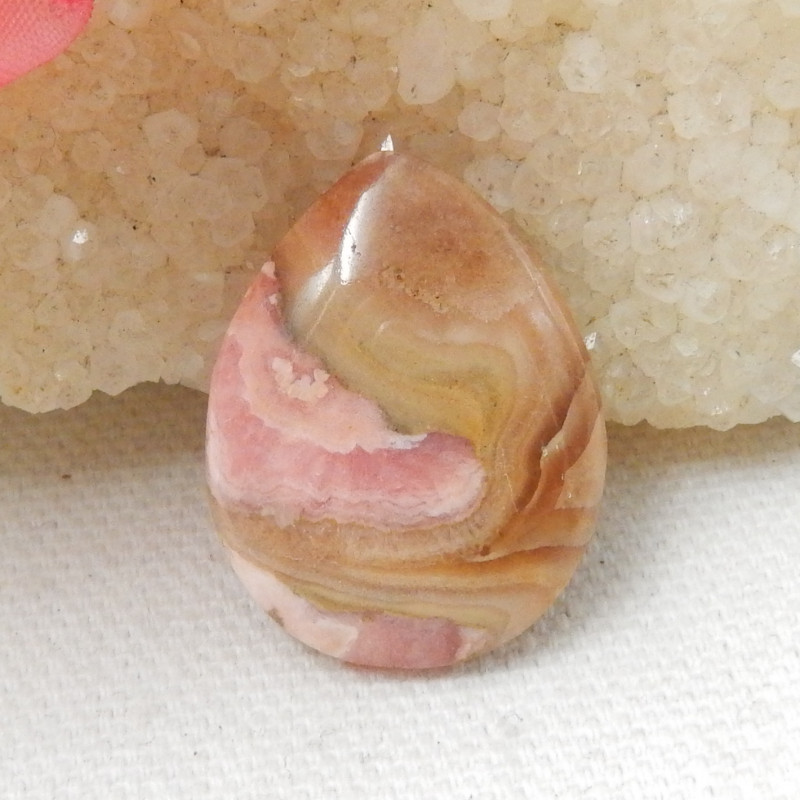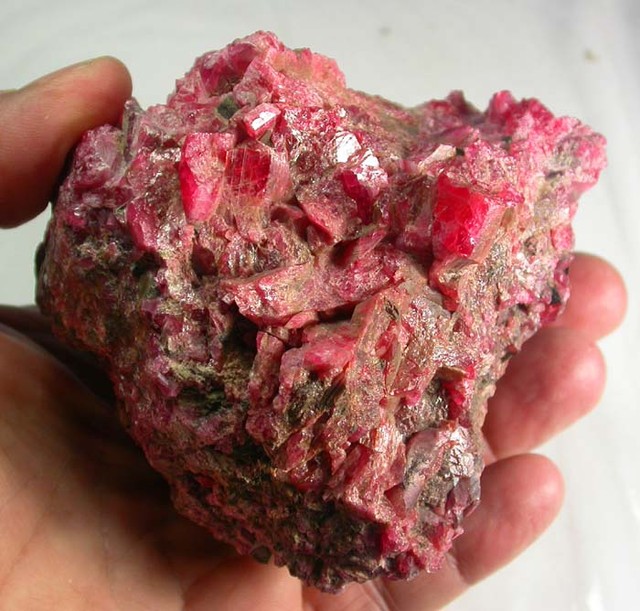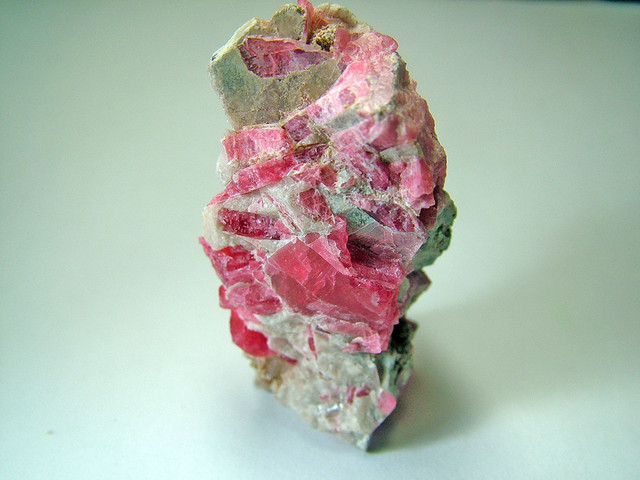
Rhodonite Stone: Meaning, Healing Properties, Uses & More
 No gemstone collection is truly complete without the compelling rhodonite stone. Rhodonite’s rosy pink coloring is reminiscent of warm, flushed cheeks on a summer afternoon. Its black streaks, along with its rarity, infuse it with depth and intrigue.
No gemstone collection is truly complete without the compelling rhodonite stone. Rhodonite’s rosy pink coloring is reminiscent of warm, flushed cheeks on a summer afternoon. Its black streaks, along with its rarity, infuse it with depth and intrigue.
As one of the main sources of rhodonite, the U.S. takes great pride in the stone. Massachusetts even claimed rhodonite as their official state gemstone in 1979. No country takes greater pride in rhodonite than Russia, however. As the first and most abundant source of rhodonite for many years, Russia considers rhodonite one of its national symbols.
Wherever you’re from, you’re sure to enjoy rhodonite’s benefits, unique appearance, symbolism, and healing powers.
This guide will cover everything you need to know about the rhodonite stone, from its mineral properties down to uses, meanings, and spiritual benefits.

What is a Rhodonite Stone?
The rhodonite stone is a manganese silica stone that ranges from rose to crimson in color. Known for its dark matrix of manganese oxide inclusions, rhodonite doesn’t shy away from other minerals. The inside of rhodonite can be a party of various elements, from calcium to zinc.
Speaking of parties, does your birthday fall under Taurus or Cancer? You’re in luck! Rhodonite is a modern zodiac stone for these two signs. If the traditional emerald or ruby birthstones are too flashy for you, you’ll love rhodonite’s down-to-earth energy. Plus, its symbolism is rooted in unwavering love, perfect for the Taurus and Cancer traits of loyalty and compassion.
While rhodonite isn’t a birthstone, it’s perfect to use during fall. Its warm autumn colors and grounding vibrations can enhance your connection to Earth and make the adjustment to a new season easier.
Just like the changing seasons, rhodonite’s specifications can vary a bit.
Rhodonite Specifications and Characteristics
Rhodonite is a manganese silicate stone that can show optical effects like pleochroism, although weakly, and sometimes chatoyancy. Manganese is a crucial mineral for all life forms — without it, we wouldn’t have oxygen to breathe!
You might recognize the term “silicate” from other gems like quartz or tourmaline. However, rhodonite is in a sub-group of silicates called the pyroxene group, while quartz and tourmaline stones belong to different groups. It sounds complicated, but just know that each group’s gems have different chemical structures that influence their crystal shape.
Chemical compound: Manganese inosilicate (but composition can vary)
Mohs scale: 5.5-6.5
Color: Rosy red, pink, crimson, red-orange, brownish-red, gray; Black veining is typical
Crystal structure: Triclinic
Luster: Vitreous (glass-like); Sometimes pearly
Transparency: Transparent to translucent; Sometimes opaque
Refractive index: 1.71-1.75
Density: 3.5-3.7
Cleavage: Perfect 2 direction; Prismatic
Luminescence: Present; Fluorescent; Both Long-Wave and Short-Wave UV light

Rhodonite Varieties and Alternate Names
Rhodonite stones can vary based on which inclusions are present. One of the varieties is fowlerite, a zinc-rich form. Another variety is Pajsbergite, named for the city in Sweden where this type of rhodonite is found.
Some languages call rhodonite by their own name. For example, rhodonite sometimes goes by Hermannite in Russia or Cummingtonite in Germany.
Pyroxmangite isn’t a variety of rhodonite, but rather a polymorph. The two are indistinguishable without the aid of intensive scientific tests. Some consider the calcium-rich bustamite to be another variety of rhodonite, but others claim it’s a separate stone.
Whichever variety suits your fancy, you’ll first want to know the properties that factor into buying your perfect rhodonite stone.
Rhodonite Gemstone Properties
Whether you’re a first-time buyer or a long-time collector, knowing the qualities that factor into a stone’s value before you buy it is important.
For rhodonite, its key qualities are its color, clarity, and cut.
Color
It’s probably obvious by now that rhodonite is famous for its rosy red shade. Yet another identifying color for rhodonite is its dark brown or black inclusions. These inclusions appear as veins or color zones, and they’re caused by manganese oxide.
Some rhodonite stones have so much manganese oxide, they appear almost completely black due to surface oxidation (rust).
Other inclusions in rhodonite can affect its coloring as well. For instance, bustamite inclusions in rhodonite masses lead to brown or reddish-brown spots. Small green spots can occur with sphalerite inclusions, while galena inclusions create a deeper reddish-brown coloring.
Clarity
Most gemstones receive a clarity grade based on how many inclusions they have and their visibility. Colored gemstones don’t have an international grading standard, but the Gemological Institute of America has created a basic 3-tier system. Based on the GIA’s system, transparent rhodonite would fall under Type III, while opaque rhodonite is “O” for Opaque.
As the Type III classification suggests, rhodonite stones are heavily included. While inclusions typically reduce a stone’s value, rhodonite’s inclusions are one of its most intriguing properties. Because transparent rhodonite is so rare, the opaque variety with striped or swirling inclusions is more popular amongst most buyers.
Rhodonite’s most common inclusion is manganese oxide, which appears as the black dendrites we discussed above. Magnesium, calcium, and iron are typically present in rhodonite as well. Zinc is present sometimes, but not as often.
Cut
Because of rhodonite’s perfect cleavage, it’s often too delicate to be faceted by anyone who’s not a highly skilled expert. Translucent rhodonite gemstones and jewelry are available, but these pieces are rarer and command higher prices.
The more common cuts for rhodonite include sleek and polished cabochons, tumbled stones, and beads. Carvings and sculptural items are also popular for rhodonite.
In fact, rhodonite’s potential for carvings is where its history began.

Rhodonite History
Rhodonite’s history technically started in Russia. While the stone wasn’t officially recognized until 1819, miners in the Ural Mountains had been digging up large pieces since 1790.
Talented Russian carvers created all sorts of magnificent pieces from rhodonite stone: vases, obelisks, and even the sarcophagus of Czar Alexander II’s wife, Maria Alexandrovna. It’s no wonder rhodonite is considered the country’s national symbol.
As Russia started sending rhodonite carvings as diplomatic gifts, its popularity grew around the world. Eventually, the American company Tiffany & Co. used rhodonite from Massachusetts to create sophisticated kitchenware, including knives and place settings. While that particular mine is now closed, you can still see beautiful pieces from the collection on display at the American Museum of Natural History.
One common thread throughout rhodonite’s history is its use as a protective talisman. Beyond the gifts from Russian Czars, everyday folks in the Ural Mountain area started giving rhodonite to travelers and newlyweds as a protection stone. Greeks and Romans wore rhodonite amulets during long trips, and many believed it would increase the wearer’s heart rate to warn them of imminent danger.
Rhodonite spiritual meaning and metaphysical properties aren’t limited to the past! So, what is the meaning of rhodonite now?
Rhodonite Stone Meaning
Rhodonite got its official name in 1819 by German naturalist Christoph Friedrich Jasche. He used the Greek word rhodon, which means “rosy,” to reference the stone’s signature pinkish-red color.
Before 1819, rhodonite had only been known in Russia. The locals there called it Orletz, Russian for “eagle stone.” The story goes that residents found small rhodonite pieces inside eagle nests, prompting the nickname. It also prompted a local tradition of putting rhodonite in babies’ cribs or gifting it to new parents as a soothing protection stone.
Rhodonite isn’t only known for its protective properties. Rhodonite serves as a symbol of self-realization, helping to clarify one’s true purpose in life. In fact, many rhodonite lovers praise its humanistic qualities.
Rhodonite’s spiritual energies make it a great healing stone. On that note: how do you use rhodonite stone for healing?

Rhodonite Spiritual and Healing Properties
Spiritually, rhodonite is often called a “Stone of Compassion” for its many heart-healing properties. Rhodonite benefits those who struggle with their emotions, be it through bitterness or trauma.
Have you ever wanted to open your heart to someone, but felt it was too scary? Rhodonite can help by enhancing your self-confidence and helping you heal from emotional scars. Furthermore, rhodonite can give you the mental clarity to see where you’re holding yourself back.
Even for those of us with open hearts, rhodonite can attract new love to us. It can also help us care for others more, bringing out our generosity of spirit. After all, sometimes helping others can get you out of your own head.
Physically, rhodonite is known to help with hearing and skin disorders. Additionally, offering help to those dealing with wounds, bug bites, or rashes. Rhodonite is also purported to improve memory.
Speaking of memory, some of us might have some memories we’d like to forget. If your memories have made you build up emotional walls, rhodonite can help open your heart again. Once you’re open to receiving love, rhodonite can attract love to you.
What chakra is rhodonite good for? It’s probably no surprise, but rhodonite helps balance the heart chakra! When the heart chakra is unbalanced, we might feel too scared of getting hurt to put ourselves out there. With rhodonite, the heart chakra can open, allowing us to love ourselves and the people around us more fully.

Rhodonite Stone Origins and Sources
Rhodonite forms in areas where heat and water are present, either at surface level or much deeper. The process involves cool rocks being chemically altered by hot, mineral-rich water or magma.
Most rhodonite specimens are found as dense, finely-grained masses. Other minerals, like bustamite or quartz, are almost always mixed into these masses as well. Finding facetable, transparent rhodonite crystals is rare, and these specimens only range in size from 2-3 carats.
Mining Locations
Rhodonite mines are typically situated around manganese ores. Different mines are often known for producing either rhodonite masses or transparent crystals, depending on their environment.
The most impressive rhodonite masses have come from Russia, Australia, and Sweden. Sweden also produces some of the finest transparent rhodonite crystals, along with Japan and Brazil. Other abundant rhodonite deposits are in Canada, Tanzania, and Argentina.
Where is rhodonite found in the U.S.? While Massachusetts is the only state that claims rhodonite as their official gemstone, New Jersey’s Franklin Furnace mine produced some of the most iconic rhodonite crystals at its prime. Other U.S. rhodonite deposits are in California, Montana, and Colorado.
If you enjoy looking for gemstones yourself, you may be wondering: How do you identify rhodonite?
Rhodonite Identification
As we’ve discussed, rhodonite often gets confused with other similar-looking stones. How can you tell if rhodonite is real? The easiest way is to know the stones that get mislabeled as rhodonite and how they differ from true rhodonite stones.
Rhodochrosite: Rhodochrosite is softer than rhodonite. Rhodochrosite is soluble in hydrochloric acid, while rhodonite isn’t. Rhodonite’s veining is dark, while rhodochrosite has white swirling bands.
Thulite: Thulite is harder than rhodonite and doesn’t have the dark color banding that rhodonite does.
Rhodolite: Rhodolite is a type of garnet stone, while rhodonite is a silica stone. Rhodolite is transparent, unlike the more commonly opaque rhodonite. Lastly, rhodolite has higher clarity than rhodonite.
Knowing how to differentiate rhodonite is helpful for both explorers and everyday buyers. Let’s discuss rhodonite stone price and the factors that affect it.
Rhodonite Price and Value
Large rhodonite crystals or dark crimson specimens are the most valuable forms of rhodonite. Transparent rhodonite specimens are hard to come by, so they command higher prices.
Transparent, crimson rhodonite crystals between 1-10 carats can cost anywhere from $150-$500 per carat, and sometimes more for richer-colored stones. Similar rhodonite stones over 10 carats can be $500-$1000 per carat.
You can still find affordable rhodonite jewelry; it’s just more likely to be the opaque variety. Opaque rhodonite usually costs between $0.25-$2.50 per carat. Cabochons that show chatoyancy are the most valuable opaque variety and can be up to 5 carats.
No matter what kind you buy, you can get the most bang for your buck by ensuring your rhodonite stone lasts with proper cleaning and care.
Rhodonite Care and Maintenance
The softest rhodonite is the transparent variety, while opaque rhodonite tends to be tougher because of its inclusions. If you have a transparent rhodonite stone, be sure to take extra caution when handling it.
With either variety, take care to avoid hard blows to your rhodonite gem. The stone’s brittleness and perfect cleavage make it especially vulnerable to cracks or breakage.
You should also make sure your rhodonite stone doesn’t come into contact with:
Ultrasonic cleaners
Harsh chemicals
Intense heat
In terms of how to cleanse rhodonite stone, here are our top methods:
Hold the stone under a stream of water twice a month.
Keep the stone near a piece of selenite or amethyst.
Bury your rhodonite in soil for a day.
Place rhodonite under moonlight or the light of sunrise.

Ready for Rhodonite?
Now that you’ve got a handle on rhodonite, you can see why this uncommon stone is an underrated beauty. It may not be as widespread as other gems, but that’s what makes it so special and worthy of your attention.
Whether you want to show your pride as a Taurus or Cancer or start healing emotional wounds, rhodonite can get you there. Better yet, tap into your generous spirit by giving a rhodonite bracelet or rhodonite stone ring as a gift.
Looking for a gem as unique as you? Find Your Rhodonite Stone Today!
Search the Gemstone Encyclopedia
Related Auctions
Related Articles
Originally the Birthstones or gemstones were associated with a zodiac sign or the month of a individuals birth. Find out what your stone is and view the stones we have for sale
8th Feb 2021
There are dozens of quartz and chalcedony gems with various colors and patterns. Learn all about quartz properties and every type of quartz, from amethyst and agate to plasma and phantom quartz!
15th Oct 2020
Hackmanite is a pink to violet sodalite gem known for its unique color-change and luminescence. Learn why hackmanite is special, from its rare qualities to the types of hackmanite jewelry available.
28th Mar 2018
Latest Articles
Catapleiite is a lesser-known mineral and rare gemstone often found as stunning tabular rosettes near other rare stones. Discover the history, prices, benefits, and properties of catapleiite!
28th Apr 2025
Yugawaralite is a rare colorless, white, or pinkish zeolite crystal named for its discovery in Yugawara, Japan. Here we uncover the multifaceted history, properties, prices, and uses of yugawaralite.
24th Mar 2025
Simpsonite is a lesser-known mineral known on the gem market for its durability, yellow-orange color, and rarity. Discover all the properties, uses, prices, and history of simpsonite.
3rd Mar 2025
Article Categories
How To's is where you will find helpful articles from gem Rock Auctions on how to cut gemstones, select gemstones and buy gemstones.
9 Articles





